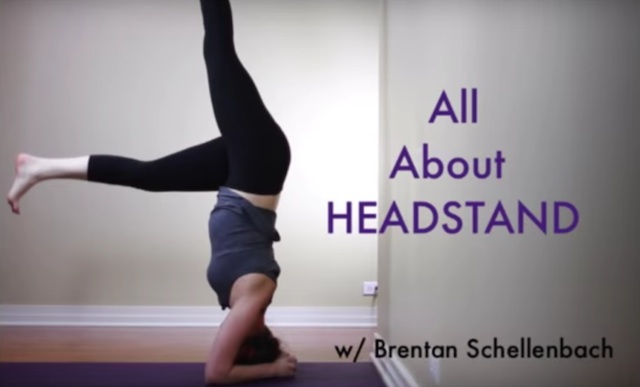At first it seems like staying upright without wobbling over in a high lunge is the impossible feat to conquer.
Then it seems like balancing on one foot is the culprit.
And then, excuse me—what? You want me to balance on my head?
When it comes to headstand, here are a couple of tips to make the impossible possible.
Headstand is basically an upside-down version of tadasana (mountain pose) with the arms curling around the head. This means that tadasana is a great prep pose to get a feel for what will be asked of your body when you flip it upside down.
Understanding the shoulders comes next. The shoulders are the base of the pose, which means they are the star players (so to speak) and need to be two things: flexible and strong.
You can test your flexibility by noticing whether your chest and upper back are open enough to move the arms overhead without moving the spine or ribcage with them.The spine and ribcage will need to be in their tadasana positions during headstand, which means that headstand won’t work if they move out of tadasana alignment when the arms lift overhead.
This can be easily tested from tadasana or right from your chair. Align the spine so the shoulders are sitting right over the pelvis and the torso is equally activated on all sides. Without moving the spine or the front ribs, lift the arms overhead. If they can lift alongside the ears without moving the spine or ribcage with them, you’re good to go! If the spine and ribs move (either into a backbend shape or a hunchback shape), that’s a normal experience, and simply indicates that you will probably want to pursue some chest and shoulder openers before trying headstand.
Once shoulder flexibility has been secured, you can move on to strength. The shoulders (and by proxy, forearms, since they are what actually touches the floor) should absorb the weight of the body rather than the skull, so they need to be efficient energy masters of pushing down (into the floor) and hugging in (to the midline). When the shoulders are able to do this in headstand, the pressing down energy will secure a lightness to the head and spine (protecting the spine and spinal chord from possible injury), and the hugging in will start a core conversation (ever hear yoga teachers talking about the core in headstand? It starts here!) and make the pose feel accessible and easy to hold.
The strength of the shoulders is conditioned in every pose where they bear weight, which means downward facing dog can turn into a wonderful headstand prep with the right focus. Try sphinx pose and dolphin pose to start bearing weight on the shoulders with the forearms on the floor, which is what the ultimate arm position will be in full headstand. The best time to try headstand is when poses like this feel easy, or at least doable (if not likeable).
The shoulders are really the biggest mystery to master when it comes to making headstand more achievable, but there are certainly other things that may cause confusion for students. For instance, the backs of the legs (hamstrings) need to be pretty open for the transition into headstand (time to ramp up that forward fold practice!). Fear can sometimes stop students from even trying the pose. The wall can be both a help and a hindrance. And it’s also important to know how to fall out of inversions, not just for physical safety, but because it also fosters a positive attitude and helps curb feelings of discouragement and defeat.
And ultimately, while studying is great, there is no substitution for practicing. Studying will help you develop a theoretical understanding of the pose, but the pose itself is an experience (not a theory), and therefor needs to be practiced (usually with a lot of clumsy, ugly repetition).
Here is an at-home practice I recently put together, combining both the theory and practice of headstand. As a yoga student, I love studying theory, so I love practices that combine theory into the actual experience of the yoga poses. As a yoga teacher, I love sharing the insights and golden truths that have made so many seemingly impossible yoga poses possible for me and for so many of my students.
Because ultimately, the pose is a tool to understand ourselves, and that is how I want to teach it. Enjoy:
More from Brentan:
Be Your Own Teacher: Yoga Guide For the Hips & Low Back. {Video}
Relephant:
Headstand? No problem—It’s All About That Base. {Funny Video}
Author: Brentan Schellenbach
Editor: Renée Picard
Image: screenshot











Read 0 comments and reply